If you’re thinking of sewing curtains to enhance the window features, create a romantic ambiance in your bedroom, or block out the early morning sun from disturbing your sleep, there are several fabrics to select.
Curtain fabrics are available in two types, sheer and opaque. Blackout fabrics are heavier, keep out light, and act as a control mechanism for temperature and noise. Curtains have several functionalities, and you also need to consider the weight, texture, and filter properties of the fabrics.
Every homeowner desires a home that’s aesthetically appealing, offer privacy, and keep the outside world from the inside. If you are unsure what fabrics to choose, here is a summary of the best fabrics for making curtains if you wish to sew them yourself.
- 11 Best Fabrics For Making Curtains
- Sheer Fabrics For Curtains
- Opaque Fabrics For Curtain
- 4. Damask Brocade And Jacquard
- 5. Velvet Curtain Fabric
- 6. Taffeta Curtain Fabric
- 7. Cotton And Cotton Blend Curtain Fabric
- 8. Linen Curtain Fabric
- Blackout Curtain Fabric
- Unsuitable Fabrics For Curtains
- Our Verdict on the Best Curtain Fabrics
11 Best Fabrics For Making Curtains
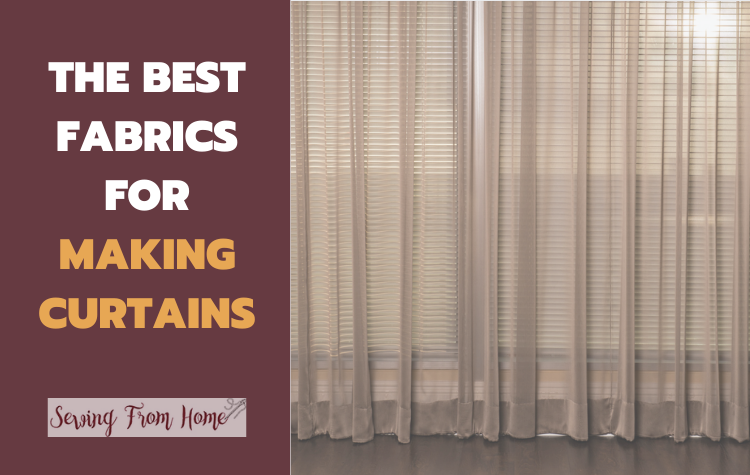
Whether you require a new bedroom curtain or a whole new window treatment, it’s essential to find the best fabrics for curtains. This involves some research before you take the leap and purchase the fabrics.
Sheer Fabrics For Curtains
Sheer curtain fabrics offer more aesthetic appeal than functional ones. You may use them in kitchens or bathrooms, where natural light is welcomed. Alternatively, they are used behind heavier fabrics or in front of blinds.
On the downside, although sheer curtain fabrics look great and give a room a romantic appeal, they are unsuitable for bedrooms, dining rooms, etc. They don’t provide much privacy or restrict light or insulation.
There are several sheer curtain types to examine if they are your fabric choice. Mentioned below are a few sheer curtain examples.
1. Chiffon And Voile Curtain Fabrics
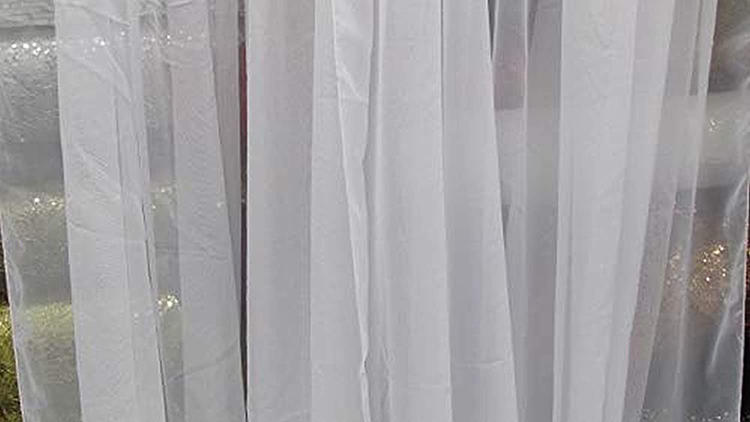
Think airy; bellowing in the breeze, sunlight spilling through, those are words to describe these two sheer curtain fabric types.
Chiffon fabric is constructed from polyester or silk fibers, while voile is a lightweight 100 % cotton or cotton blend fabric.
As lightweight fabrics, both these examples are ideal for filtering more light into your room. Voile mainly also provides some privacy because the fabric surface is so fine.
Because the fabrics are lightweight and provide more privacy, you can layer the curtains. There are a few ways you can proceed with that. You can use rods with single, double, or multiple rails.
Both chiffon and voile curtain fabrics drape well and are easy to clean. However, voile as a natural fabric is a dust and stain collector and, therefore, may need to be laundered more regularly than other curtain fabrics.
2. Lace And Net Curtain Fabrics
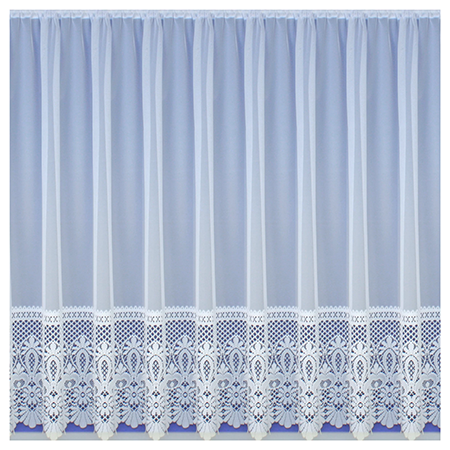
You would be wrong to think that lace or net is outdated fabrics! They have just been re-purposed and are gaining popularity as curtain fabrics. The open weave on lace allow sunlight to filter through and create fun patterns on hard surfaces.
Lightweight and delicate fabrics are ideal for a country-style kitchen or bathroom, or if you’re feeling adventurous, try them in your bedroom for a dreamy, romantic appeal.
However, curtains require a lot of fabric and lace on the more pricey scale of curtain fabrics. They are ideally suited for smaller size windows. However, if your mind is set on lace, less expensive types are available.
Polyester net is also available if you are working on a budget. Net is thin and lightweight enough to filter natural sunlight into an otherwise dark and gloomy room.
You’ll want to look for a non-stretch net. Sewing net with stretch can be a nightmare for the inexperienced machinist.
3. Muslin Curtain Fabric
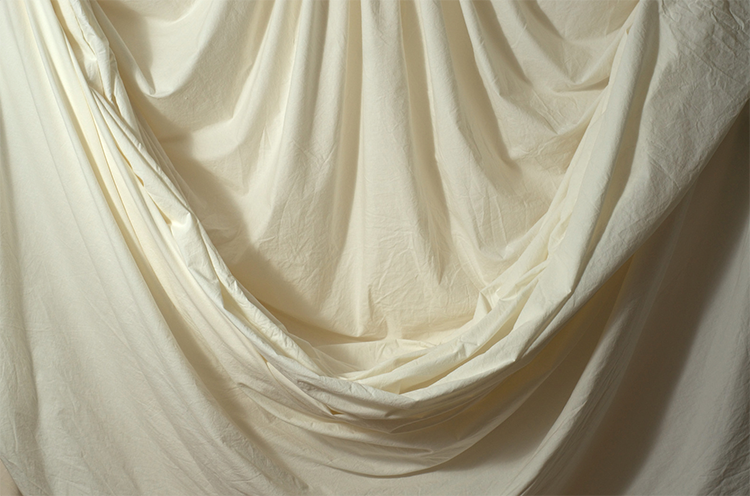
Muslin is a well-known sheer curtain fabric because it is inexpensive compared to other sheer curtain fabrics. It is also constructed of cotton fibers, is lightweight, and breezy enough to allow air circulation and light to filter through.
Muslin can be useful as a curtain fabric because it is not as sheer as the other sheer curtain fabrics mentioned.
These sheer curtain fabrics are ideal because they allow sunlight into the room and are lightweight. However, they cannot withstand harsh sunlight, and they may fade after extended periods of exposure.
Opaque Fabrics For Curtain
You’ve taken a walk through sheer curtain fabrics but haven’t found anything appropriate. Perhaps you should look at opaque fabrics. Opaque fabrics are more heavyweight, such as Damask, Linen, Velvet, etc.
Opaque fabrics automatically lend a bit of oomph to any room. The heavy curtains cut out the sunlight while rendering the room cozy, warm and comfortable. Those are the qualities you require in curtains for your rooms. Think luxury hotel rooms.
4. Damask Brocade And Jacquard
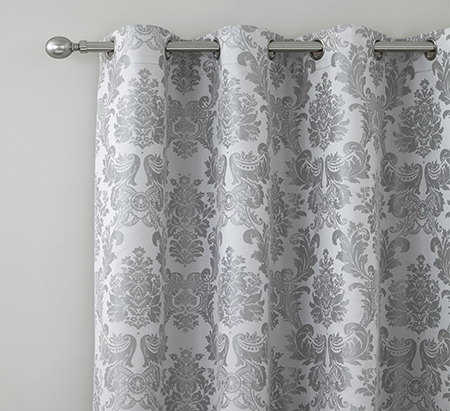
These opaque curtain fabrics are self-embossed woven fabrics, available in cotton, silk, and linen including synthetic fabrics. They are heavier in weight, and the weaving method creates a glossy sheen to the fabric’s surface.
With Damask, you see a two-toned effect, the same color in two shades, when light hits the fabric’s surface, while brocade produces patterns in contrasting colors.
Brocade, Damask, and jacquards are your best bet in keeping out the cold if you have a sizeable drafty room.
Although heavier in weight, they drape and hang very well, which you require in curtain fabrics. However, these fabrics also require some additional care. They require linings to protect the fabric’s surface from fading too fast.
It is preferable to use cotton as a lining fabric with opaque fabrics.
5. Velvet Curtain Fabric
Velvet is an expensive fabric for curtains because of its textured nap and weight. It is thick, heavy, and regal and will undoubtedly keep out the cold.
Velvet is a delicate fabric and should therefore only be dry-cleaned. It does pick up dirt and dust very quickly, so to clean, use a soft-bristled brush and comb along with the nap.
Due to its propensity to fade quickly, velvet also requires a cotton lining to preserve the fabric.
Care should be taken in ensuring the curtain rod is secured firmly onto the wall because this opaque fabric is quite heavy, and the curtain rod may be unable to hold its weight.
6. Taffeta Curtain Fabric
Like the brocades and jacquards, taffeta also has a self-embossed pattern. It is smooth, with a glossy finish, and is available in medium to heavyweight.
Due to the weight, taffeta is a good choice for curtains because it drapes well and retains its shape.
This fabric as well requires lining and dry cleaning. A piece of advice, do not attempt to wash these curtains at home. You can damage the fabric if proper care is not taken with cleaning.
7. Cotton And Cotton Blend Curtain Fabric
There are limitless uses and advantages of cotton fabric, particularly for shirts and other types of clothing.
Cotton fabric is versatile, durable, and long-lasting, providing good insulation if required while still looking good even after many washes. It is valid for curtaining fabric as well.
100% cotton will shrink after the first wash, but cotton blends not so much. Therefore it’s beneficial to purchase extra fabric and add a shrinkage allowance when cutting out your curtains. Shrinkage allowance is usually added to the length of the curtains.
Popular cotton fabrics used for curtains are poplin, chintz, and twill. These are available in light, medium, and heavyweights in various colors and prints. Cotton twill has an ingrained pattern, which is attractive in curtains.
If the rooms are south facing, they receive much sun. Therefore lining curtains is practical because it protects the main curtain fabric from fading quickly. Cotton curtains also need lining. Remember to use a lining similar in weight to the base fabric.
For smaller windows, you may choose dress fabrics, Madras cotton, or gingham check. These fabrics are only available in smaller widths and are unsuitable for larger windows. They can be used on larger windows but require more than a single piece to cover the window length.
8. Linen Curtain Fabric

As a natural fabric linen is versatile, easy to clean, and durable. The attractive feature of linen is the natural slubs found in the fabric. These result from the weaving method and give the fabric a textured surface.
Linen curtain fabric is also available in light, medium, and heavyweights and suitable for nearly every room in your home. Sheer linen fabric is also available if you prefer that type of curtain.
Like the many benefits linen fabric has; the one disadvantage is that it creases very easily. Therefore avoid cleaning these linen curtains at home and instead send them to be laundered.
However, the good news is that the appearance of linen curtain fabric improves with every wash. There are linen blend curtain fabrics available that combine the best of both worlds, and you don’t have the problems of creasing to stress you.
Blackout Curtain Fabric
As the name suggests, blackout fabric is heavyweight that shut out not just sunlight but also surrounding noise, which is especially helpful if you live on a busy street.
Blackout curtains are also beneficial for large, drafty rooms as they insulate the room exceptionally well.
Usually, good-quality blackout curtains are constructed with a tightly woven fabric that restricts sunlight.
9. Polyester And Micro Fiber Curtain Fabrics
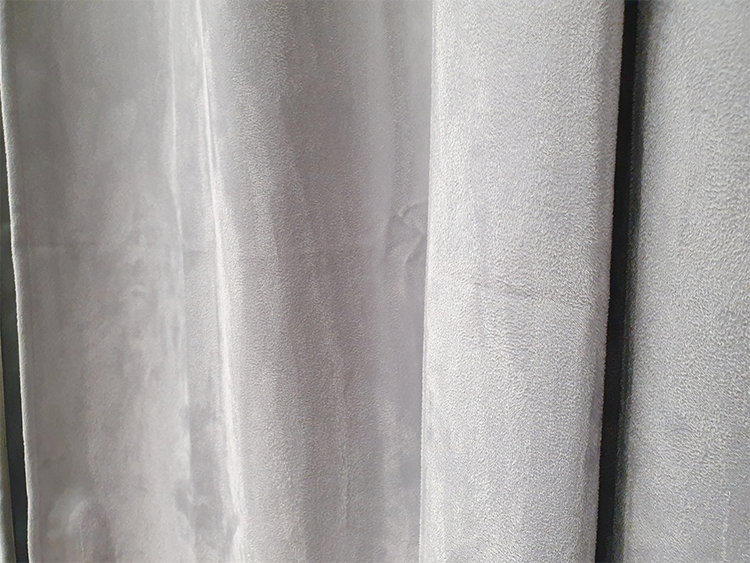
Polyester is a perfect fabric for blackout curtains because it is durable, solid, and inexpensive. There is no need to stress about creasing or shrinkage with polyester curtain fabric, for it is an easy to clean fabric.
Microfiber fabric has a 90% rate of restricting light. Heavyweight microfiber fabric is especially perfect for blackout curtains because of the triple weave construction process. Because of the polyester fibers used, this curtain fabric is also great for managing and maintaining insulation in rooms.
10. Thermal Fabric For Curtains
When winter sets in, you look for reasons to stay indoors; coziness and comfort are on your list. To keep out the cold from inside your home, you may want to invest in thermal fabric for your curtains. Thermal curtain fabrics include heavyweight fabrics like cotton and Polyester.
They filter out the cold, provide good insulation therefore are ideal as window treatments. Thermal curtains are not beneficial only for winter but during summer they control the inside from overheating.
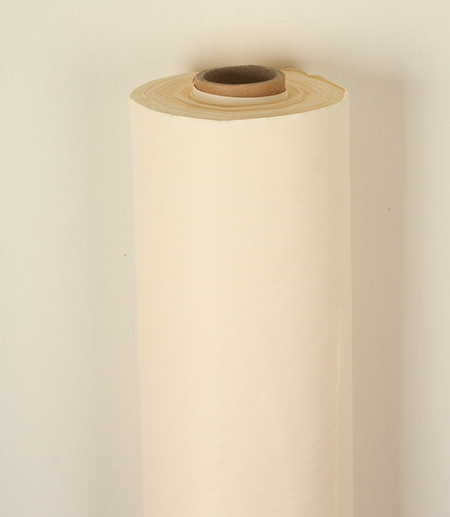
11. Lining Fabrics For Curtains
Most if not all curtains require linings of some sort.
Lining curtains protect the base fabric from the sun’s harsh rays, which result in the curtains fading quickly. And if you want to protect your furniture, books, and paintings from the sun’s UV rays, you should line your curtains.
Light to medium-weight curtains requires lining fabrics as this helps with curtains draping well. The linings will also protect your privacy if you use sheer curtains.
You have a few options available as lining fabrics.
- Cotton is always the better option. It protects curtains against the sun, gives them suitable drapes, and makes them look elegant.
- Polyester, synthetic fabric is durable, affordable, and does not crease. Polyester lining fabrics are not prone to mildew and color fading.
- Cotton and Polyester are suitable lining fabrics for your light to medium-weight curtains.
- You may use poly-cotton sateen twill for the medium to heavyweight curtains.
- Polycotton sateen twill lining is a polyester and cotton blend with a satin finish. It is ideal for lining curtains because it is crease-resistant and available in various widths.
Unsuitable Fabrics For Curtains
There are certain fabric types unsuitable for making curtains.
Avoid Knit Fabrics For Curtains
Avoid stretchy fabrics such as Single Jersey knit, spandex or lycra. Gravity is not friendly to stretch fabrics, primarily when used as curtains. Knit fabrics snag and tear easily, so therefore unsuitable for curtains.
Avoid Upholstery Fabrics For Curtains
You should also avoid using upholstery fabrics for curtains. Most upholstery fabrics have a plastic coating behind them. The coating prevents a good drape and hang of the curtain.
Upholstery fabrics are also heavier than standard curtains. You may find the bottom hem flaring out like an accordion!
Our Verdict on the Best Curtain Fabrics
Curtain fabrics are available in various colors, prints, and styles.
Combining multiple curtain fabrics gives your window treatment extra dimension and flare. Remember some fabrics may be better suited for blackout or sheer curtains!
Our list above will help steer you in the right direction, but we’d love to hear what fabrics you’ve been using in your own projects!
